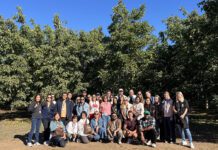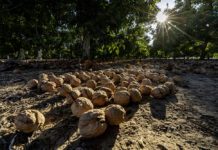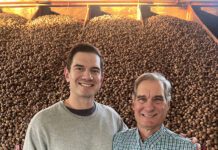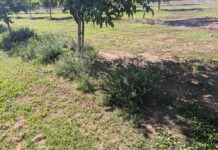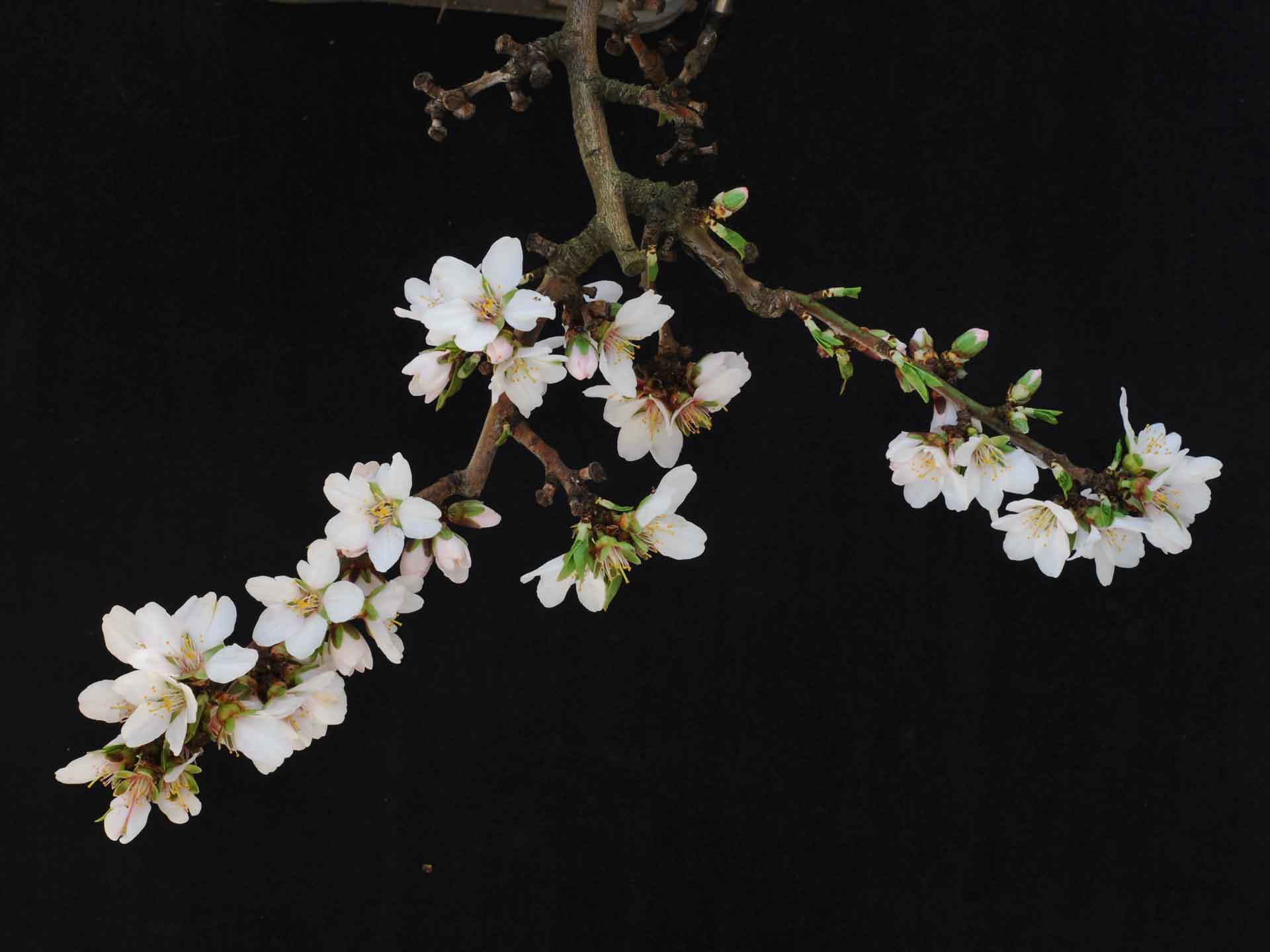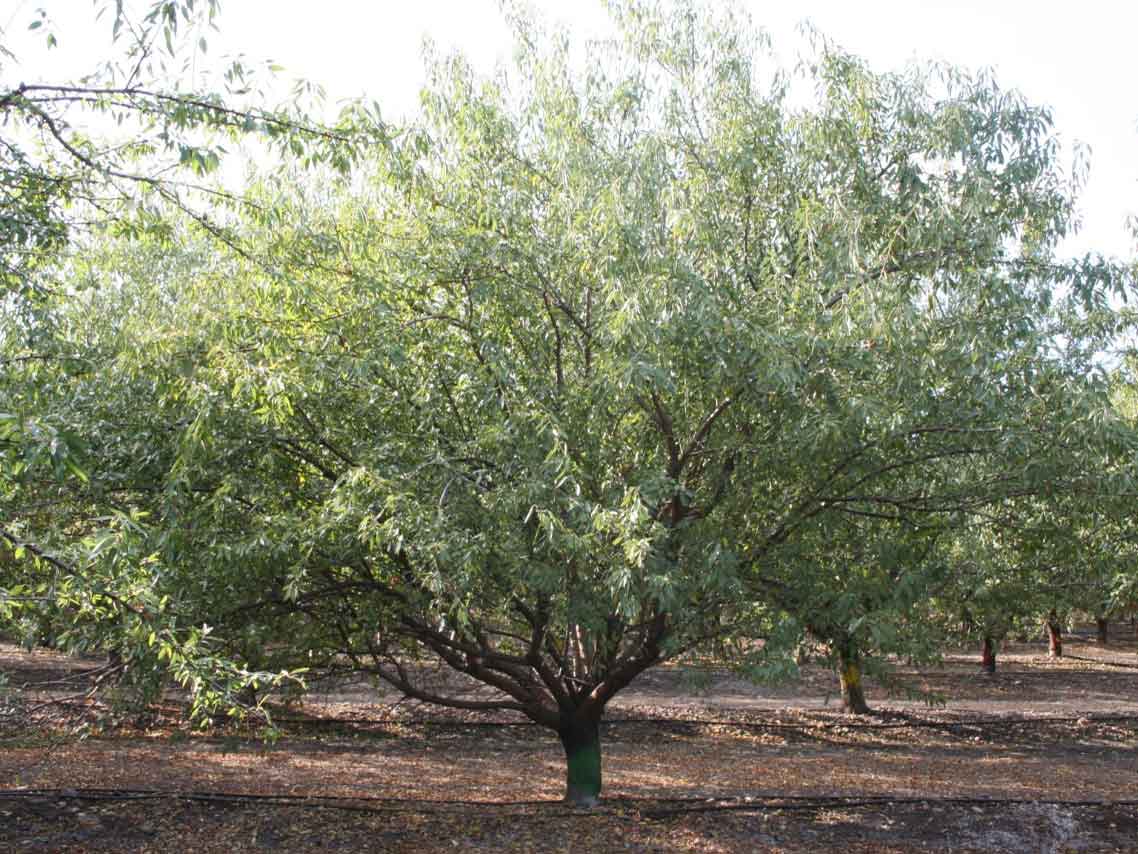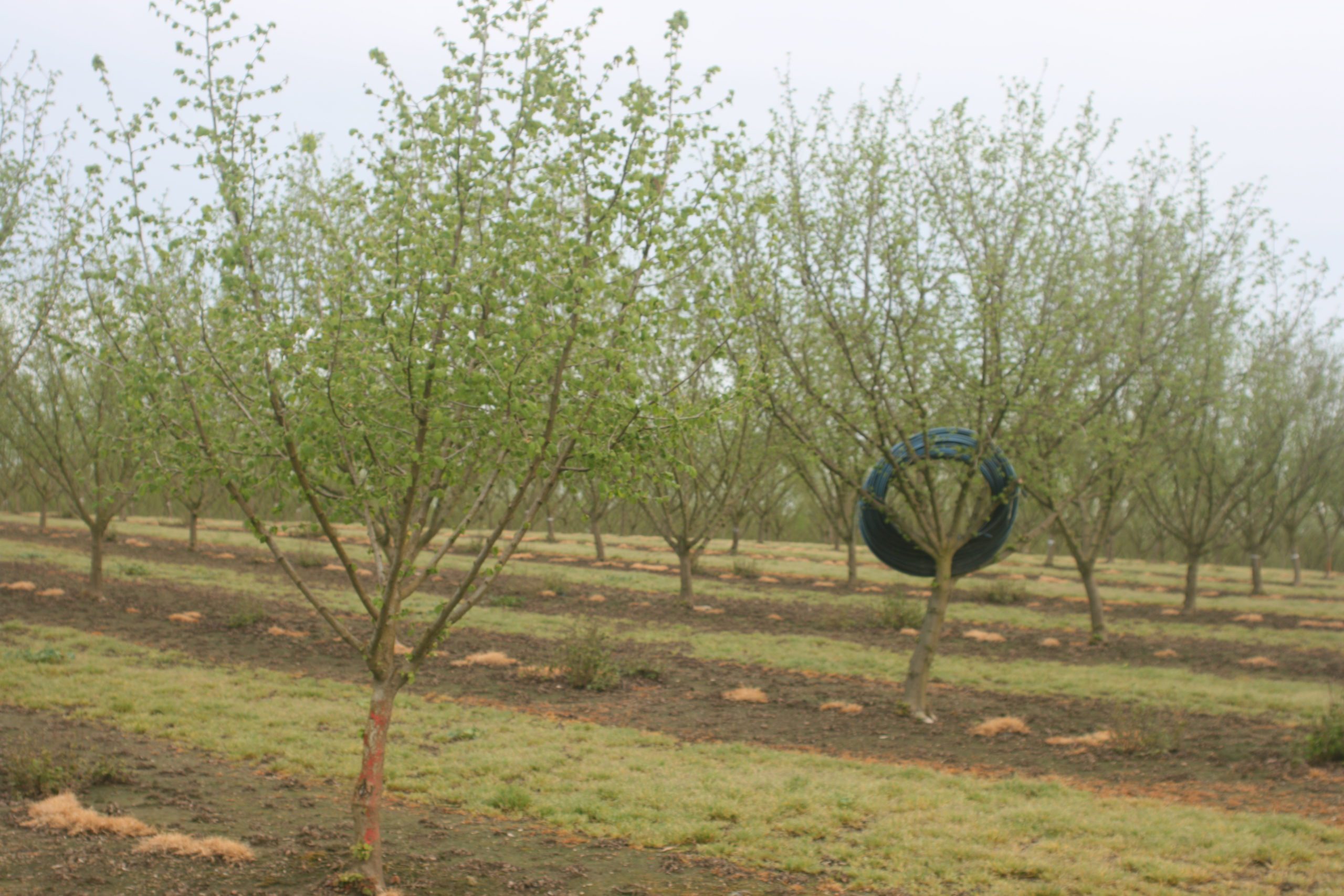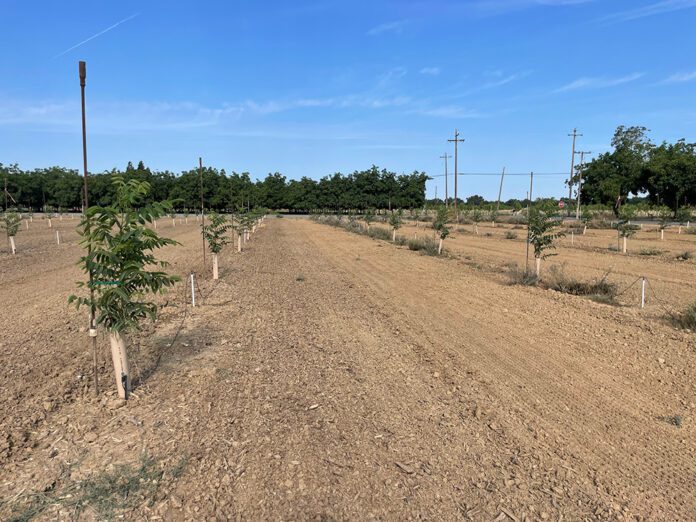
Listen to the audio version of this article. (Generated by A.I.)
Brent Holtz, orchard systems farm advisor for San Joaquin County, started research on whole-orchard recycling (WOR) in almonds over two decades ago. WOR happens when trees are chipped on site rather than burned, and the chips are incorporated into the soil before replanting.
WOR has become the primary orchard removal method in the Central Valley due to reduced burning for air quality. Holtz’s research has identified significant advantages to WOR, from increasing soil health and productivity to improving soil moisture content.
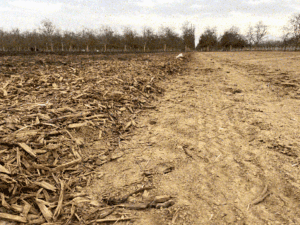
WOR
Holtz has expanded his research to walnuts. “We’ve got a couple of trials going now with walnuts,” he said.
The main difference between using WOR in almonds versus walnuts is that in walnut orchards, especially older ones, there could be more biomass than in almond orchards. Almond trials averaged 50 to 65 tons per acre of wood chips versus 75 to 100 tons per acre in walnuts, Holtz said.
“A lot of folks are worried that’s too much wood to put back in the ground and get another crop growing,” Holtz said, but he thinks it can work. It may just require proper incorporation into the ground.
Almonds incorporate wood chips in the top 6 inches of the soil. “With walnuts it should be incorporated in the top foot, and then it would be about the same concentration of wood chips per square inch,” Holtz said.
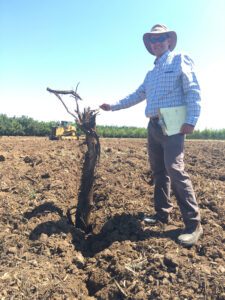
Current WOR Walnut Research
Clarissa Reyes, orchard systems advisor for Sutter-Yuba, Butte and Placer counties, said there are currently three sites for walnut orchards with WOR: two in Sutter County and one in San Joaquin County.
The first demonstration site was established in Sutter County in 2021 on sandy soil near the Bear River. Ninety-one tons per acre of chips were spread and incorporated into the soil in five blocks of two treatments. One control had no chips and one had WOR treatments with chips. The field also has four different commercial rootstocks (Grizzly, RX1, Vlach, VX211) planted to evaluate their growth in soil with no chips and with WOR.
“Trunk circumference is measured annually to compare growth of the WOR treatments. In 2024, there was no significant difference in growth or tree survival between the control and soil with chips. A field day will be held this summer (2025) for growers to come and observe the research field,” Reyes said.
After the first site showed that walnut trees could grow successfully with WOR, two more sites were established recently to evaluate WOR in walnut on additional soil types in two walnut-growing regions. The WOR site in San Joaquin County had 60 tons per acre of chips incorporated in 2022, and trees were planted in late 2023. The second WOR site in Sutter County had 80 tons per acre of chips incorporated at the end of 2023, and trees were planted shortly after in January 2024. Both newly developed orchards have Wolfskill on Grizzly rootstock.
Holtz’s work in almond has shown that WOR requires nitrogen management that differs from conventionally planted orchards due to nutrient tie-up. For WOR in almond, N application is increased in the early years of orchard establishment to supplement N that is initially immobilized by microbial communities as they break down carbon in the applied chips. After a couple of years, the orchards should benefit from N mineralization, the release of N when the wood chips are decomposing, Reyes said.
“At the two new walnut WOR sites, we are again comparing general growth and survival in control vs WOR treatments, but this time we are also hand applying various rates of additional nitrogen fertilizer for the first three years to develop some fertilization guidelines for WOR in walnut during early orchard establishment,” Reyes said. “So far the research orchards have only been established for one year, so there is not much data to report, but stay tuned in the coming years for findings.”
WOR and Disease
Incorporating diseased trees is cited frequently as a concern. “We really haven’t seen a disease problem in almonds or walnuts,” Holtz said.
At a recent farm advisor tour, oak root rot was discussed. Oak root rot is a disease that is in the roots and spreads from root to root. When an orchard is removed, all the underground roots aren’t removed, which means diseased roots are left in the soil.
“We probably only get less than half of the roots out of the ground when we pull the trees out to chip. So if there was a disease harbored on the roots, it’s still going to be on those roots if they don’t come out of the ground. If you have that disease, I don’t think it’s a big deal whether you burn what you pull out of the ground or not. You’ve still got diseased roots underground,” Holtz said, adding there is some evidence the oak root rot fungus, Armillaria, does not like to be wood chipped.
Avocado and citrus farm advisors in Ventura County did a study on Phytophthora, a fungus that has cellulose in its cell walls, which is what makes up wood. They found that if they put mulch around citrus and avocado trees, it helped reduce Phytophthora because there are other fungi and bacteria producing cellulases, enzymes that break down the wood, that also break down Phytophthora’s cell walls, Holtz said.
There are also some studies where wood chips actually helped with disease control rather than made it worse. A new tree was planted where an old tree died from oak root rot, and one of the treatments was wood chips. That turned out to be the best treatment. They found that the wood chips were colonized by Trichoderma, a genus of fungi in the family Hypocreaceae that is present in all soils, which is believed to be antagonistic to Armillaria.
“I think there’s more that could be a benefit than a risk,” Holtz said.
Benefits to WOR
“Extensive WOR research in almond has demonstrated increased carbon sequestration, increased soil health, increased water-use and nutrient-use efficiency, and reduced nitrogen leaching potential relative to conventional orchards,” Reyes said.
“This research has not yet been conducted in walnut orchards with WOR, but now that we’ve established these two new WOR sites, we will be collecting data on physical, chemical and biological properties of the soil there, as well as tree growth, survival and disease,” Reyes said.
A weed survey was conducted at the new Sutter site last summer to evaluate the effects of WOR on initial weed incidence. “There was significant suppression due to WOR. In the tree rows, there was 58% weed coverage in control soil versus only 14% weed coverage in the tree rows that had WOR chips,” Reyes said.
Building soil organic matter is also a benefit. “As the wood chips decompose, they’re mineralizing or releasing nitrogen. Initially those wood chips are immobilizing nitrogen, they’re tying it up, but as they decompose, they’re mineralizing nitrogen and making it available to the next crop,” Holtz said.
WOR also increases water infiltration, and research has shown less nitrogen leaching into soils.
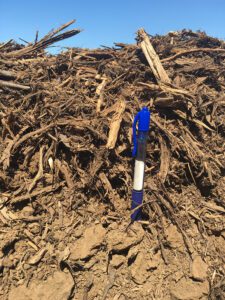
Funding
Burning in the Central Valley has been greatly reduced, making WOR more appealing to growers for crop removal. The San Joaquin County Air Pollution District is offering incentive programs to reduce burning by recycling versus burning old orchards.
“I think growers can get close to $1,000 an acre from the air board, and about $300 million has been given out to growers for whole-orchard recycling. The funding is through the San Joaquin Valley Air Pollution Control District,” Holtz said.
“In the Sacramento Valley, a burn permit from the respective air quality management district is required, and burning is only allowed on designated burn days,” Reyes said.
Reyes has received questions from growers who have walnut orchards that are now aging out of prime production and considering WOR. “The practice is not as heavily incentivized in the Sacramento Valley as it is in the San Joaquin Valley, but there are still programs that growers can apply for up here to help with the cost of implementation,” she said.
There is funding for north state growers as well as Central Valley growers at:
• Natural Resources Conservation Service (NRCS) Environmental Quality Incentives Program (EQIP): WOR qualifies as a soil carbon amendment.
• NRCS Conservation Stewardship Program (CSP): Chipped orchard material can be used as a conservation practice to reduce particulate matter emissions by using orchard- or vineyard-generated woody material as mulch.
• CDFA Healthy Soils Program: WOR qualifies as a Healthy Soils management practice. UC ANR Climate Smart Agriculture Program technical assistance providers are available to help with CDFA Healthy Soils applications. There are multiple TSPs in the Sacramento Valley: ciwr.ucanr.edu/Programs/ClimateSmartAg/TechnicalAssistanceProviders/index.cfm
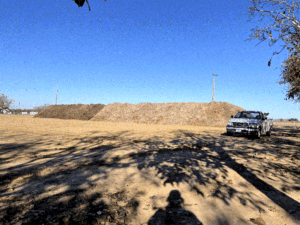
WOR in Pistachios
Holtz hasn’t seen interest in WOR for pistachios mainly because these trees have more longevity than almonds or walnuts.
“The early orchards are still producing, and they really haven’t taken out old pistachio orchards. Some of the early ones had Verticillium and had to be replanted, but I haven’t actually seen an old pistachio orchard come out yet,” Holtz said.
Orchard Removal Companies
There are several orchard removal companies up and down the Central Valley, Holtz said. Early on, these companies would remove the orchard for free and haul the wood chips to cogeneration plants, where the plant bought the wood chips from the orchard removal company, Holtz said. But with the loss of the cogeneration plants, that is no longer the case.
There are orchard removal companies in every region from Bakersfield north in the Central Valley. To find orchard removal companies, go to the WOR website at UC Davis: orchardrecycling.sf.ucdavis.edu/california-orchard-recycling-resource.
“WOR is expensive, and growers don’t like having to spend more money to do things that used to get done for free, but I think we’re going to look back and say we used to burn our orchards. That didn’t make sense,” Holtz said.






